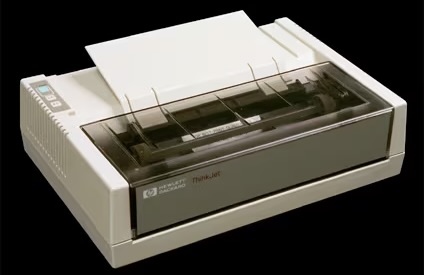
The concept of inkjet printing was a fixture throughout the 20th century – with research starting way back in the 50s with a Japanese Canon employee, Ichiro Endo, who proposed the idea for a "bubble jet" printer that could translate the images you see on a computer to a printed physical page. But it wasn't until HP's ThinkJet printer launched in 1984 that inkjet printing truly entered the mainstream – and with it the dreaded ink cartridge.
One of the first commercial inkjet printers was the IBM 6640, a device designed to offer printing to offices, when it was launched in 1976. It was part of a handful of bulky, heavy and impractical devices that launched around this time – and offered inkjet printing in professional contexts.
But nearly ten years later, HP brought out a more compact machine for personal printing at home. Measuring 11.5 x 8 x 3.5 inches, the black-and-white printer would have set you back $495 – $1,478.45 by today's standards. Its ink cartridges, which were available for $8 a pop ($24) were good for 500 pages too.
The dot-matrix disruptor
Its name is derived from the process of 'thermal inkjet' printing – and came about when an engineer working on a completely different project noticed something interesting about the effects of electricity. When they were making thin-film technology for integrated circuit applications, they were testing how a thin silicon film would respond when stimulated with electricity. To the engineer's surprise, the electricity superheated the medium and droplets of fluid lying beneath the film were expelled. This, according to HP, inspired the idea for finely controlled jets of fluid in a compact inkjet printer.
This invention was a game-changer. While, as we've mentioned, inkjet printing was in force across enterprises – these machines could only print large characters rather crudely. Now, it was clear this technology could be reduced in size and operate with relatively little power compared to its business-centric cousin.
It also marked an end to the dot-matrix printer, which was replaced a technology that was better in almost every metric – to the extent it's still one of the most popular types of printer today. For instance, dot-matrix printers typically printed at 120 characters per second, while the HP ThinkJet printed at 150 characters per second. The former technology also emits high-pitch scratching sounds, too, while the inkjet printer emits a "nondistracting hum that is quiet enough not to interfere with telephone conversations," according to InfoWorld (1984).
More from TechRadar Pro
- These are the best printers out there today
- Check out the best home printers we've found
- We've also round up the best HP printers on offer right now







